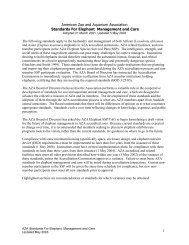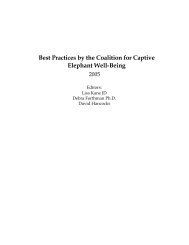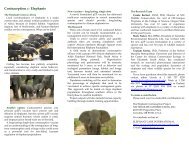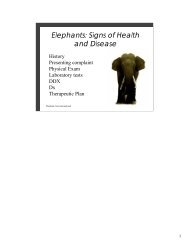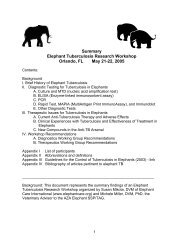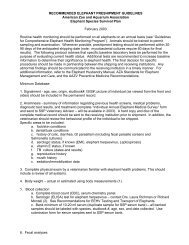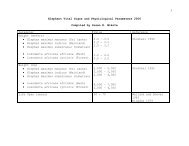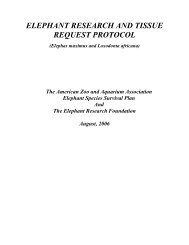Nepal Elephant TB Control and Mgt Action Plan.pdf - Elephant Care ...
Nepal Elephant TB Control and Mgt Action Plan.pdf - Elephant Care ...
Nepal Elephant TB Control and Mgt Action Plan.pdf - Elephant Care ...
- No tags were found...
You also want an ePaper? Increase the reach of your titles
YUMPU automatically turns print PDFs into web optimized ePapers that Google loves.
<strong>Nepal</strong> <strong>Elephant</strong> Tuberculosis ulosis<strong>Control</strong> <strong>and</strong>Management agemen<strong>Action</strong> <strong>Plan</strong> (2011-2015)2015)treatment should be segregated <strong>and</strong> restrictedfrom work unl they have completed 30consecuve full doses of an-<strong>TB</strong> drugs.Group 3 elephants (<strong>Elephant</strong> <strong>TB</strong> Stat-Pak ® reacve/ DPP ® Vet<strong>TB</strong> reacve) should be segregated<strong>and</strong> restricted from work <strong>and</strong> public contactunl the elephant has completed 90 consecuvedoses of an-<strong>TB</strong> drugs. Culture posive elephantspotenally have more advanced disease <strong>and</strong>should be segregated <strong>and</strong> restricted from workfor the duraon of treatment.Majority of the elephants have tendencyof refusing medicaons. The <strong>TB</strong> drugs arebi er-tasng <strong>and</strong> many tablets are required.Prophylacc treatment lasts nine months <strong>and</strong>full <strong>TB</strong> treatment lasts one year so it is importantto take me to slowly condion the elephant toaccept a new roune before starng medicaon.Once the elephant accepts the new roune theyare more likely to complete the enre treatmentwithout a problem. Each elephant is different <strong>and</strong>requires paence <strong>and</strong> ingenuity to determine thebest method for each individual elephant. Thefollowing methods have been used successfullyin <strong>Nepal</strong>. Note that the paral doses suggestedbelow during the condioning period do notcount toward the full dose goal.Method 1. Direct administraon in smallmolasses balls or bananasBegin training elephants to accept small ballsof molasses with no medicaon. These shouldbe small enough to be placed towards the backof the elephant’s tongue so that they swallowthem without chewing. Each elephant shouldreceive about 100-150 small molasses balls eachday in the morning before other food. Once theelephant rounely accepts the un-medicatedmolasses balls, the drugs may be added graduallyas described below. Place only 1-2 pills in eachmolasses ball. Once the medicaons are reliablyaccepted at the full dose it is best to give them allat once in the morning before the elephant eatsa lot of food. If this does not work then the drugscan be divided so that the elephant receives 1/2of the pills in the morning <strong>and</strong> 1/2 in the evening.Small pieces of banana (with skin), eachcontaining 1-2 pills can be used in place ofmolasses <strong>and</strong> may work be er for someelephants. Sugar should not be used as itintereferes with the absorpon of INH.Method 2. Direct administraon in large molassesballs (or dana/ kuchi)Some elephants have accepted mulple tabletsin large molasses balls or in their regular dana/kuchi.Method 3. Direct administraon in the mouthA few elephants have been trained to open theirmouths widely <strong>and</strong> will accept the pills beingtossed directly into their mouths. The pills shouldbe followed by a liter of water to make sure thatthey swallow.Introduce INH-RIF at 80% of the calculated dose.Place 1-2 pills in small molasses balls (or bananapieces). Try to place in the back of the mouth sothat the elephant does not crush <strong>and</strong> taste thedrugs. Place several pills if using large molassesball or dana/kuchi.Once INH <strong>and</strong> RIF have been accepted for 3 daysin a row, increase to 90% of the calculated dose.Once INH <strong>and</strong> RIF at 90% of the calculated doseare accepted for 3 days in a row, increase to 100%of the calculated dose. If there are any problemsnoted at 100% of the dose, back down to 90%.For Group 3 elephants it is important to add EMBas soon as possible a!er the INH <strong>and</strong> RIF are12




